There is a special exploration labelled “AlphOmega Signal Scan”. It will show all the waves in 3 timeframes. We sacrifice some of the information such as the fast sensitivity but we get an overall look. It will take longer to run and will show some N/A where the function is not yet defined for the sensitivity or there is no pattern for that sensitivity. For comparative purpose, it runs 30 minutes for 5,000 securities with a 950-megahertz processor. While these explorations are rather lengthy and will take some time to run on our machine; don’t forget it is looking at a lot of records and it does all the screening we would normally do. The output provides us with much information and we can open the most promising
securities right from The Explorer™. The signals will last only for a few days to prevent information overload as explained before. Another type of signal exploration is AO EW T1 and AO EW T2 that will display a list of securities that meet the conditions set up for these type of trades. T1 is a trade set up for a wave 4 that is almost complete and is about to reverse and start a wave 5 impulse. T2 is a trade set up for a confirmed wave 5 that is nearing its end. A displaced moving average is used to anticipate the trend reversal. A summary of these trade set ups is provided in the annex at the end of the manual. The explorations are provided to demonstrate how the Elliott Waves could be used in trading analysis. We could certainly improve on them by adding our own experience with our preferred indicators.
The set is so designed as to enable us to call formula variables into our own formulas. All the AlphOmega formulas can be used with any system we create and within systems, indicators, experts or explorations. We can also use our password to alter values. Explorations can be used for other purposes than finding a list of securities that match the search criteria. We can create an exploration that will give the results of a back test on the whole database. Below is a sample that shows the output of such a back test. These explorations have been removed from the set as the new System Tester of MetaStock® 8.0 simplifies this kind of back testing.
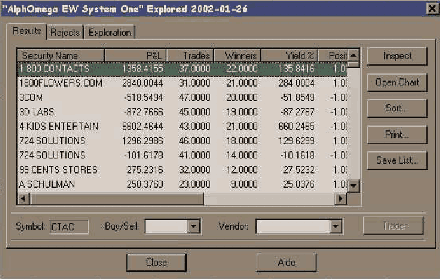
Fig. 35
This is a screen shot of the back testing performed in an exploration no longer provided in the set. We can design such explorations by using the indicators provided with the set. The programming is demanding and the testing must be thorough to avoid signals we could not possibly pick in time for trading purposes.
Please note that many explorations like Fig. 35 will display two different pieces of information where the label will read “ID.Bars” and the column will show 5.5015 for example. The integer part is the wave number while the decimal part is the number of bars since the signal (trigger), so in this case a forming wave 5 that is 15 bars old. This enables the display of more than 6 pieces of information for a single exploration. Another way of displaying more information is using a minus sign on the column data to indicate an exit from the trade; the column heading would then be labelled for example: Close/X. Refer to the description header of the exploration for specifics.
AlphOmega Impulses %GT is an exploration to find how many impulses were profitable between the entry and the exit signal. The report columns display for 3 sensitivities 1) the percentage of good trades over total trades 2) the integer is the number of good trades while the fraction is the number of all trades. This way we know if the percent is meaningful as a good percentage over many trades is more reliable than a 100% on one trade.
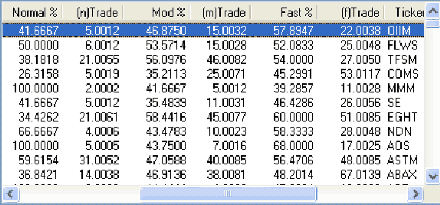
Fig. 36
AlphOmega Normal (I) explores the database for impulses at the 21% sensitivity only. It has a volume and price filter to eliminate securities without real trading volume. The report columns display the wave number and bars since signal, a stop loss computed at signal time, the last close or if there is a minus sign in front of the number it is the exit price, the entry price after the signal, the cumulative profit between the entry price and the close or exit, the percent profit over the entry price. AlphOmega Wave Points does the same thing but using 3 points instead of percentage. It scans the database for triggers. Columns are different though as shown in figure 37a.
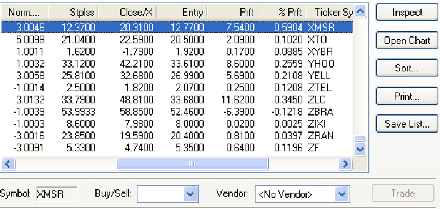
Fig. 37
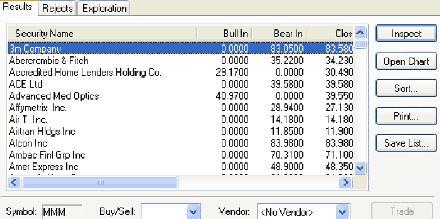
Fig. 37a
AlphOmega RSI Trend Violation is similar to the AlphOmega Trend Line Violation exploration shown below. The report columns display the wave number (negative is a bearish pattern), the stop loss at the violation bar, the last close or exit price as the previous exploration, the entry price at the bar following the cross, the expected price target and the percent profit between the entry price and the close or exit.
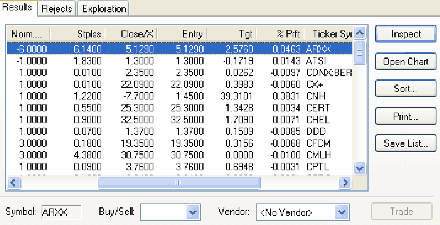
Fig. 38
AlphOmega Signal Scan is exploring 3 sensitivities for recent confirmation signals (less than 3 bars). If we look carefully at the report, we can see that at least one of the three sensitivities will be less than 3 bars old. The second column is giving us the percent of change since the signal. So 0.0556 stands for 5.56%.
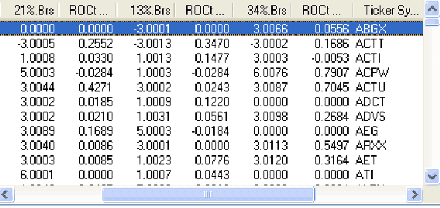
Fig. 39
AlphOmega Vidya is based on Tushar Chande’s indicator and it will scan for a cross of the Vidya line. The Vidya indicator is an adaptive moving average so its average accounts for sudden volatility changes. The report columns show Long and Short trades (-1 is a short), the stop loss, the last close or exit price, the entry price, the accumulated profit since the entry, the profit as a percentage of entry price.
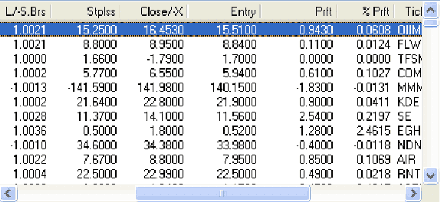
Fig. 40
AlphOmega Elliott Waves (X%) is the base exploration as it produce the wave count for all waves, corrective and impulsive, for all securities at all prices. The report columns provide 2 wave counts, the highest being the preferred count and the lowest being the alternate count if the wave fails. The alternate is dropped as soon as the wave confirmation signal is given. In addition, the report columns give the stop loss and the entry price.
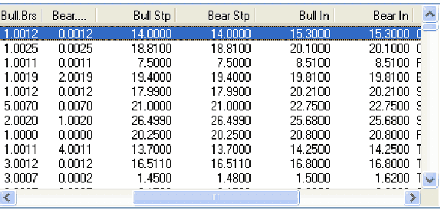
Fig. 41
AO EW T1 is a setup exploration to detect wave 4 that has a PTI of 35 or more and that has moved into the Trend Range Channel. The report columns display in the integer portion a 4 for bull or bear patterns. The fractional part is the number of bars since the confirmation signal of the wave. Shown also is the Elliott Oscillator value, the PTI (Profit Taking Index), the deepest channel line (W4 TRC) and the last closing price.
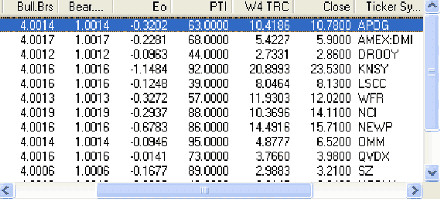
Fig. 42
AO EW T2 is another setup exploration to detect a wave 5 about to end. The report column displays for the integer a 5 and bars since signal in the fractional part. Other columns are the Elliott Oscillator, the DMA (Displaced Moving Average), the minimum target price for wave 5 and the last closing price.
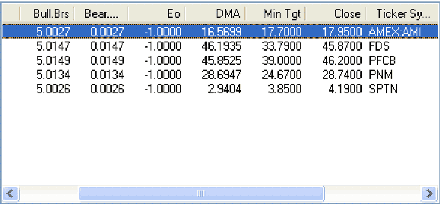
Fig. 43
AO RSI Divergence is an exploration that scans for divergence between the RSI (Relative Strength Index) and the price. If the divergence is more than 3%, it will be listed. The report columns are the 3% divergence signal, bull or bear divergence, the last closing price and the volume.
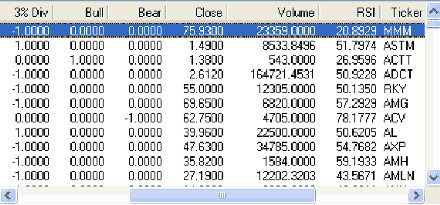
Fig. 44
AO Triangle Exploration is scanning for triangles formed by waves. It scans 3 sensitivities and the report columns provide a signal where minus is bearish triangle and the number of bars since the making of the triangle.
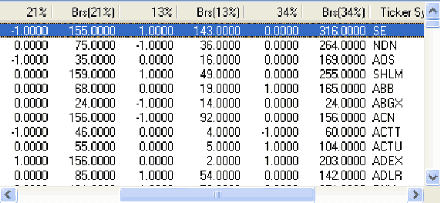
Fig. 45
AO TSI looks for crossings in the TSI to generate a signal either bullish or bearish. TSI is made of 2 moving averages, a slow and a fast, a signal is issued when they cross while the direction of the crossing gives a bullish or bearish signal. The report columns display the signals and the number of bars since the signal (in the fractional part), the value of the closing price when the signal occurred, the exit signal for bull and bear and the profit (difference between entry price and last close or exit price).
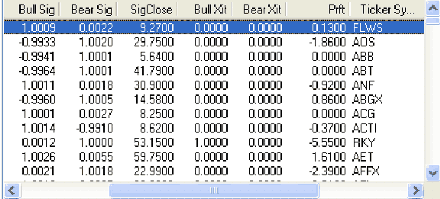
Fig. 46
AO Wolf Five n-perf scans for wolf wave setups once the last phase is engaged (refer to wolf wave pattern explanation above) for the 21% sensitivity. The report shows the signal (+ or -) and bars since, the target price, the entry price, the expected percent gain, the last close and the percent gain from entry to the last close.
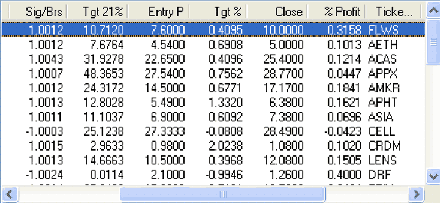
Fig. 47
AO WolfWave Normal scans for wolf wave patterns at 21% sensitivity before they engage in the last phase. The report columns show the signal (+ or -), the target price, the last close, the target gain, bars since the wave confirmation signal and bars to the target.
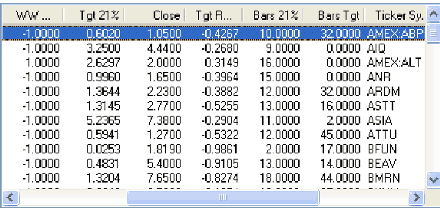
Fig. 48
Note that in explorations where the profit is shown, on the bar that the signal is issued, the profit percent or value will not always be 0. The Explorer™ keeps accumulating the prior data and does not clean the buffer until new data is available. The formula feeds continuously the delta of price to this buffer. After one bar all numbers are correctly restated.
AOi Explorations
The intraday explorations do not work like the other explorations. They must be run on intraday data. If you do not store intraday data on your computer, you must select your data provider’s database and run the exploration from his server. This is very slow so you should explore only a small number of symbols. These explorations are very sensitive and will yield too many signals on an end of day database. Once the database issue settled, we can say these explorations are yielding identical report formats and work in the same manner as the end of day explorations. However the volume and price filters have been removed as we cannot expect to have the same volume on intra day bars and the variation is too large from 60 minute to one minute bars. It is easy to set a volume or price filter by entering the edit mode of the exploration and going to the filter tab to add our filters.
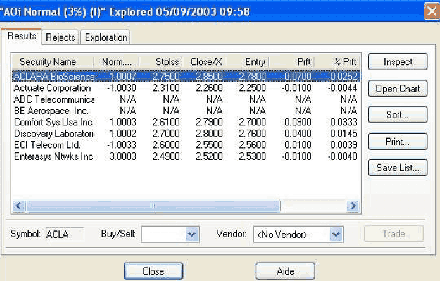
Fig. 48a
Next: Systems
Summary: Index